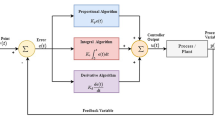Abstract
Roller conveyor line (RCL) plays an important role in smart manufacturing workshop and modern logistics industry. RCL transfers the specified type of workpiece box to specified exports according to the personalized demands. It greatly improves the sorting speed and delivery speed of workpiece. However, the construction of RCL is very time-consuming and difficult because of the unintuitive design and complex control. In order to reduce the difficulty of constructing RCL and eliminate the gap between design and control, a research about cyber-physical system (CPS) for design and control driven by digital twin (DT) is conducted. In this research, three key enabling technologies of constructing five-dimensional DT for RCL are illustrated in detail as follows: (1) multi-scale modeling method of RCL; (2) extensible distributed communication framework; (3) fast mapping method of distributed controllers. Finally, this paper provides a case study of using the CPS driven by DT to design and control RCL. Experimental results show that the CPS in this paper can achieve the rapid design and distributed control of RCL.











Similar content being viewed by others
References
Arai S, Iwatani Y, Hashimoto K (2011) Fast sensor scheduling for spatially distributed sensors. IEEE Trans Autom Control 56:1900–1905
Atzori L, Iera A, Morabito G (2010) The internet of things: a survey. Comput Netw 54:2787–2805
Baheti R, Gill H (2011) Cyber-physical systems. Impact Control Technol 12:161–166
Barenji AV, Barenji RV, Hashemipour M (2016) Flexible testing platform for employment of RFID-enabled multi-agent system on flexible assembly line. Adv Eng Softw 91:1–11
Cerrone A, Hochhalter J, Heber G, Ingraffea A (2014) On the effects of modeling as-manufactured geometry: toward digital twin. Int J Aerosp Eng 2014:1–10
Derler P, Lee EA, Vincentelli AS (2011) Modeling cyber–physical systems. Proc IEEE 100:13–28
Erra U, Capece N (2019) Engineering an advanced geo-location augmented reality framework for smart mobile devices. J Ambient Intell Humaniz Comput 10:255–265
Glaessgen E, Stargel D (2012) The digital twin paradigm for future NASA and US Air Force vehicles. In: 53rd struct dyn mater conf special session: digital twin, Honolulu, pp 1–14
Grieves M (2011) Virtually perfect: driving innovative and lean products through product lifecycle management. Space Coast Press, Florida
Grieves M (2014) Digital twin: manufacturing excellence through virtual factory replication. White Paper 1:1–7
Guo J, Zhao N, Sun L, Zhang S (2019) Modular based flexible digital twin for factory design. J Ambient Intell Humaniz Comput 10:1189–1200
Han J, Pei J, Kamber M (2011) Data mining: concepts and techniques. Elsevier, Amsterdam
Humphries E (2001) Vegetable transport operations with horizontal roller conveyors. Appl Eng Agric 17:5
Khloponin V, Tinigin A (2012) Effectiveness of active and pseudo-active methods of slowing the cooling of the starting stock on a hot strip mill. Metallurgist 55:745–752
Leng J, Zhang H, Yan D, Liu Q, Chen X, Zhang D (2019) Digital twin-driven manufacturing cyber-physical system for parallel controlling of smart workshop. J Ambient Intell Humaniz Comput 10:1155–1166
Li X (2010) Collaborative multi-sensor tracking in mobile wireless sensor networks. Int J Sens Netw 8:233–246
Luo W, Hu T, Zhang C, Wei Y (2019) Digital twin for CNC machine tool: modeling and using strategy. J Ambient Intell Humaniz Comput 10:1129–1140
Popescu M, Staton DA, Jennings S, Schnuttgen J, Barucki T (2013) A line-fed permanent-magnet motor solution for drum-motor and conveyor-roller applications. IEEE Trans Ind Appl 49:832–840
Schleich B, Anwer N, Mathieu L, Wartzack S (2017) Shaping the digital twin for design and production engineering. CIRP Ann 66:141–144
Schluse M, Priggemeyer M, Atorf L, Rossmann J (2018) Experimentable digital twins—streamlining simulation-based systems engineering for industry 4.0. IEEE Trans Ind Inform 14:1722–1731
Schmidt M, Thoroe L, Schumann M (2013) RFID and barcode in manufacturing logistics: interface concept for concurrent operation. Inf Syst Manag 30:100–115
Söderberg R, Wärmefjord K, Carlson JS, Lindkvist L (2017) Toward a digital twin for real-time geometry assurance in individualized production. CIRP Ann 66:137–140
Tao F, Qi Q, Liu A, Kusiak A (2018a) Data-driven smart manufacturing. J Manuf Syst 48:157–169
Tao F, Zhang H, Liu A, Nee AY (2018b) Digital twin in industry: state-of-the-art. IEEE Trans Ind Inform 15:2405–2415
Tao F, Zhang M, Liu Y, Nee A (2018c) Digital twin driven prognostics and health management for complex equipment. CIRP Ann 67:169–172
Tuegel EJ, Ingraffea AR, Eason TG, Spottswood SM (2011) Reengineering aircraft structural life prediction using a digital twin. Int J Aerosp Eng 2011:1–14
Yao X, Zhou J, Lin Y, Li Y, Yu H, Liu Y (2019) Smart manufacturing based on cyber-physical systems and beyond. J Intell Manuf 30:2805–2817
Zhang H, Zhang G, Yan Q (2019) Digital twin-driven cyber-physical production system towards smart shop-floor. J Ambient Intell Humaniz Comput 10:4439–4453
Zhu K, Zhang Y (2018) A cyber-physical production system framework of smart cnc machining monitoring system. IEEE ASME Trans Mechatron 23:2579–2586
Zhuang C, Liu J, Xiong H (2018) Digital twin-based smart production management and control framework for the complex product assembly shop-floor. Int J Adv Manuf Technol 96:1149–1163
Acknowledgements
This work is supported by the National Key Research and Development Program of China (2018YFB1309200).
Author information
Authors and Affiliations
Corresponding author
Additional information
Publisher's Note
Springer Nature remains neutral with regard to jurisdictional claims in published maps and institutional affiliations.
Electronic supplementary material
Below is the link to the electronic supplementary material.
Supplementary file1 (MP4 44264 kb)
Rights and permissions
About this article
Cite this article
Wang, P., Liu, W., Liu, N. et al. Digital twin-driven system for roller conveyor line: design and control. J Ambient Intell Human Comput 11, 5419–5431 (2020). https://doi.org/10.1007/s12652-020-01898-z
Received:
Accepted:
Published:
Issue Date:
DOI: https://doi.org/10.1007/s12652-020-01898-z




